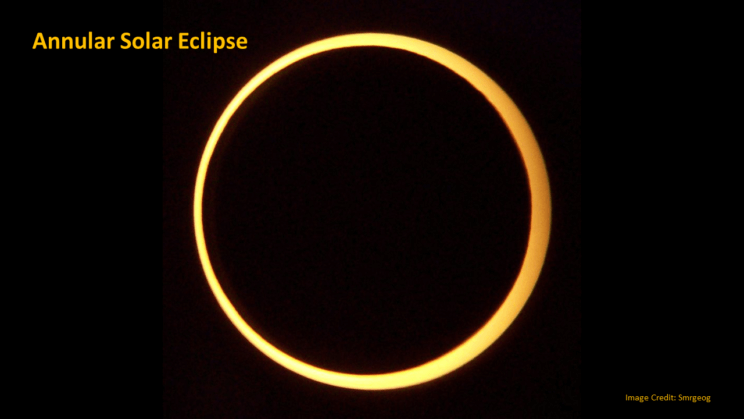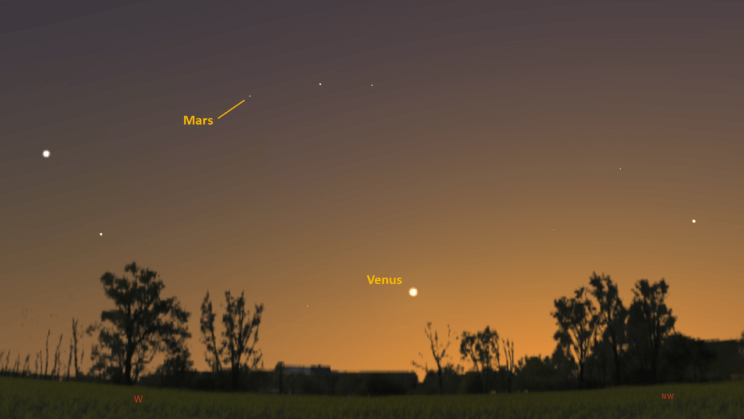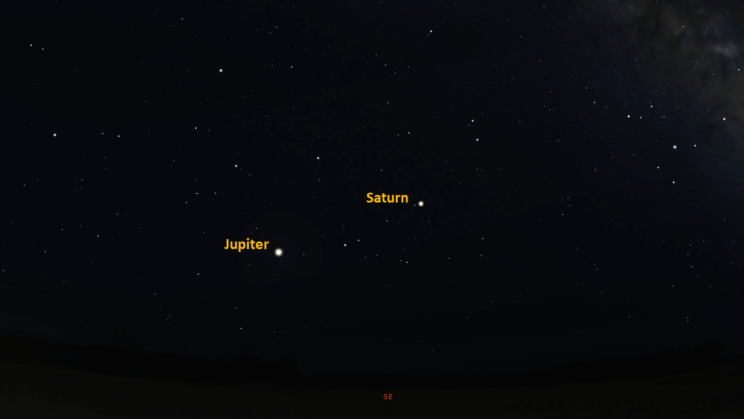This is the Saint Louis Science Center’s NIGHT SKY UPDATE for the week of Friday, June 4, 2021.
Information updated weekly or as needed.
Times given as local St. Louis time, which is Central Daylight Time (CDT). For definitions of terminology used in the night sky update, click the highlighted text. If relying on times posted in Universal Time (UT), St. Louis is -5 hours when CDT.
Public Telescope Viewings
With the changing recommendations from the CDC regarding COVID-19, conversations regarding the return of star parties at the Saint Louis Science Center have begun. We are close to bringing back our public telescope viewings, but a few details still need to be worked out. We will post future updates as we learn more about when we can bring back telescope viewings.
Observing Highlight of the Week

Annular Solar Eclipse
Credit: Smrgeog
On June 10, 2021, an annular solar eclipse will take place. Unfortunately, no portion of this solar eclipse is visible from St. Louis. This solar eclipse is the second eclipse of the current eclipse season. Each year there are normally two eclipse seasons, separated by about six months. During each season, there is always a solar and lunar eclipse, so there are at least two solar and two lunar eclipses each year. May 26 was the lunar eclipse for the current eclipse season.
An eclipse is an astronomical event called a syzygy. By definition, a syzygy is when three astronomical objects are in a straight line. The three objects involved with eclipse events we normally hear about are the Sun, Moon and Earth. A lunar eclipse occurs when the order is Sun-Earth-Moon and a solar eclipse occurs when the order is Sun-Moon-Earth. This means a lunar eclipse only occurs when the Moon is at full moon and a solar eclipse only when the Moon is at new moon.
The solar eclipse on June 10 is an annular eclipse. Because it is occurring when the Moon is near apogee, the Moon will look a little smaller than the Sun. When the Moon passes in front of the Sun, it will not cover the entire solar disk, leaving the outer edge of the Sun visible. The portion of the Sun that remains visible appears as a ring of light around the dark silhouette of the Moon. This ring is called an annulus, which is why this is called an annular eclipse.
The last annular solar eclipse seen in St. Louis was on May 10, 1994. The next annular visible in the United States is on October 23, 2023. The 2023 annular eclipse will be visible in South, Central and North America. The path of annularity in the United States is best seen in Texas, New Mexico, Utah, Nevada and Oregon. The rest of the US will experience views of a partial eclipse. In St. Louis we will see about 54% of the Sun eclipsed.
To learn more about the eclipse on June 10, 2021 visit https://www.timeanddate.com/eclipse/solar/2021-june-10
To learn more about the eclipse on October 14, 2023 visit https://www.greatamericaneclipse.com/october-14-2023
The Sun and Moon

The Moon as seen from the International Space Station, on July 31, 2011.
Credit: NASA
Sunrise is at 5:37 a.m. on Friday, June 4 and sunset is at 8:22 p.m. providing us with about 14.5 hours of daylight. Even after sunset, the light from the Sun will dimly illuminate our sky for about 2 hours. This period is called twilight, which ends around 10:18 p.m. this week. For those with a sundial, local noon occurs around 1:00 p.m. this week.
| Day | Sunrise | Sunset |
|---|---|---|
| 2021-06-04 | 5:37 a.m. | 8:22 p.m. |
| 2021-06-05 | 5:37 a.m. | 8:23 p.m. |
| 2021-06-06 | 5:37 a.m. | 8:23 p.m. |
| 2021-06-07 | 5:37 a.m. | 8:24 p.m. |
| 2021-06-08 | 5:36 a.m. | 8:24 p.m. |
| 2021-06-09 | 5:36 a.m. | 8:25 p.m. |
| 2021-06-10 | 5:36 a.m. | 8:25 p.m. |
| 2021-06-11 | 5:36 a.m. | 8:26 p.m. |
| 2021-06-12 | 5:36 a.m. | 8:26 p.m. |
Moon
Moonrise for Friday, June 5 occurs at 3:11 a.m. and moonset will occur at 4:04 p.m. On Friday, June 5 the Moon will exhibit a waning crescent phase with 17% of the lunar disk illuminated. New moon occurs on June 10 at 5:53 a.m.
International Space Station (ISS) Observing

Visible passes of ISS from St. Louis for the week of June 4 occur during evening hours. The best pass this week occurs on the evening of June 5. Use the table below for information about this and other visible passes this week. June 5 will be the last visible pass of ISS from St. Louis until June 23 when we will see the space station in the early morning.
Catch ISS from St. Louis starting Friday, June 4
| Date | Starts | Max. altitude | Ends | |||||||
|---|---|---|---|---|---|---|---|---|---|---|
| Time | Alt. | Az. | Time | Alt. | Az. | Time | Alt. | Az. | ||
| 04 Jun | -1.2 | 21:36:58 | 10 | W | 21:38:46 | 14 | SW | 21:40:34 | 10 | SSW |
| 05 Jun | -1.9 | 20:48:46 | 10 | WNW | 20:51:32 | 24 | SW | 20:54:18 | 10 | S |
Magnitude (Mag): The Measure of brightness for a celestial object. The lower the value is, the brighter the object will be.
Altitude (Alt): The angle of a celestial object measured upwards from the observer’s horizon.
Azimuth (Az): The direction of a celestial object, measured clockwise from an observer’s location with north being 0°, east being 90°, south being 180° and west being 270°.
For information about ISS flyovers and other visible satellites, visit www.heavens-above.com
Detailed information regarding all unmanned exploration of our universe, missions past, present, and planned, can be found at Jet Propulsion Laboratories:
The Visible Planets

Looking West, at 8:40 pm, June 5, 2021
Credit: Stellarium, EG,

Looking Southeast, at 2:30 am, June 6, 2021
Credit: Stellarium, EG
This week, four naked eye planets are visible. Venus and Mars can be found in the west. Mars is found in the west after sunset. Jupiter and Saturn can be found in the southeast before sunrise.
Venus
Venus is well into another evening apparition. By 8:45 p.m., Venus will be about 8° above the west-northwest horizon. As 2021 continues, we will see Venus climb higher in the western sky after sunset until October 29 when it reaches maximum eastern elongation. After this date Venus will start to head back towards the Sun as it approaches inferior conjunction on January 8, 2022.
Mars
Currently Mars appears as a 1.8-magnitude object that will be visible high in the west about 40 minutes after sunset. Mars sets by 11:13 p.m.
Jupiter
Jupiter is visible in the southeast before sunrise. Jupiter rises at 12:59 a.m. and will be easy to see in the southeast by 2:00 a.m.
Saturn
Saturn has returned to our morning sky. Saturn rises at 12:07 a.m. and will be easy to spot by 1:30 a.m. looking southeast.
James S. McDonnell Planetarium
Night Sky Update: June 4-June 12, 2021






